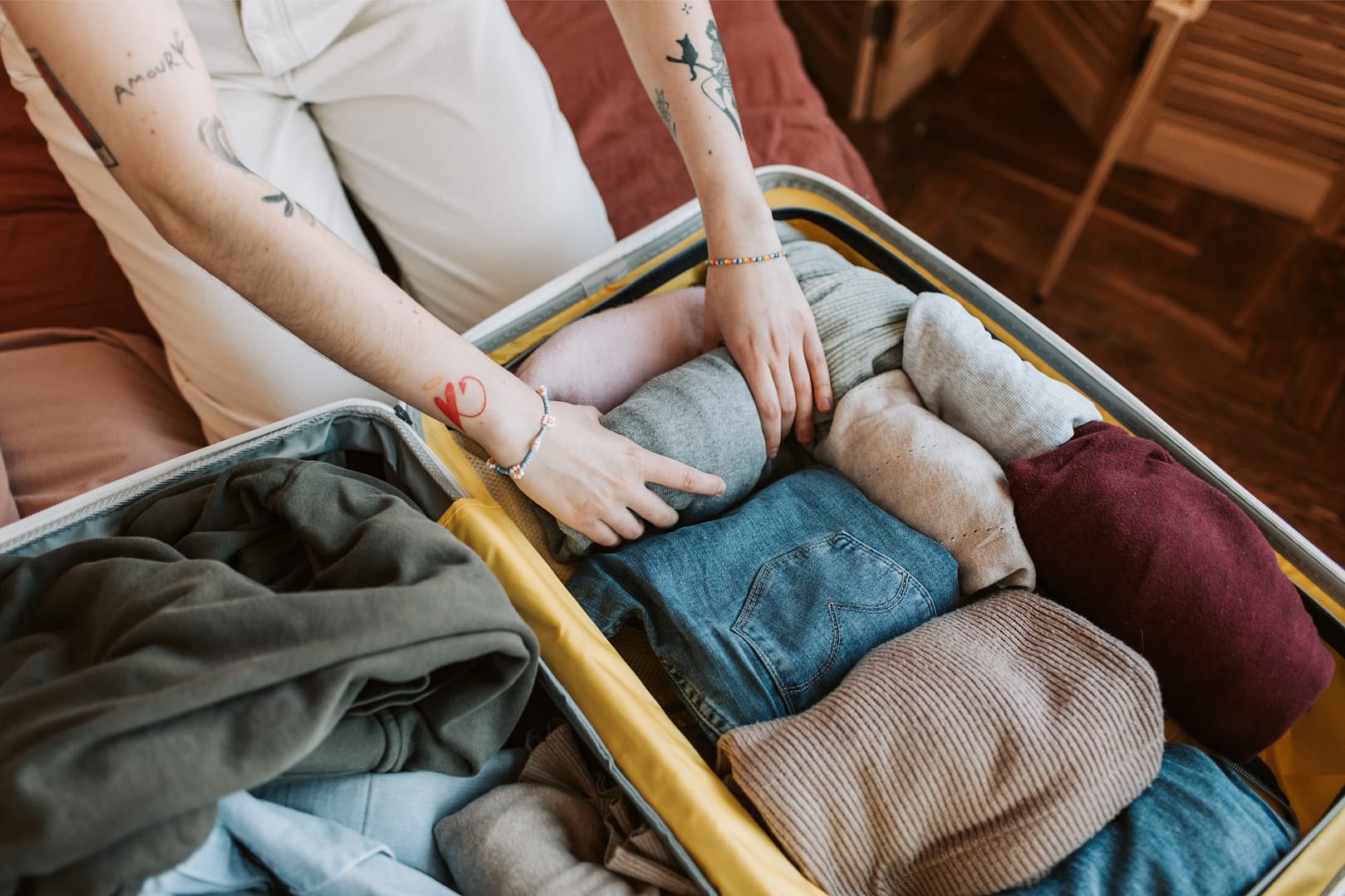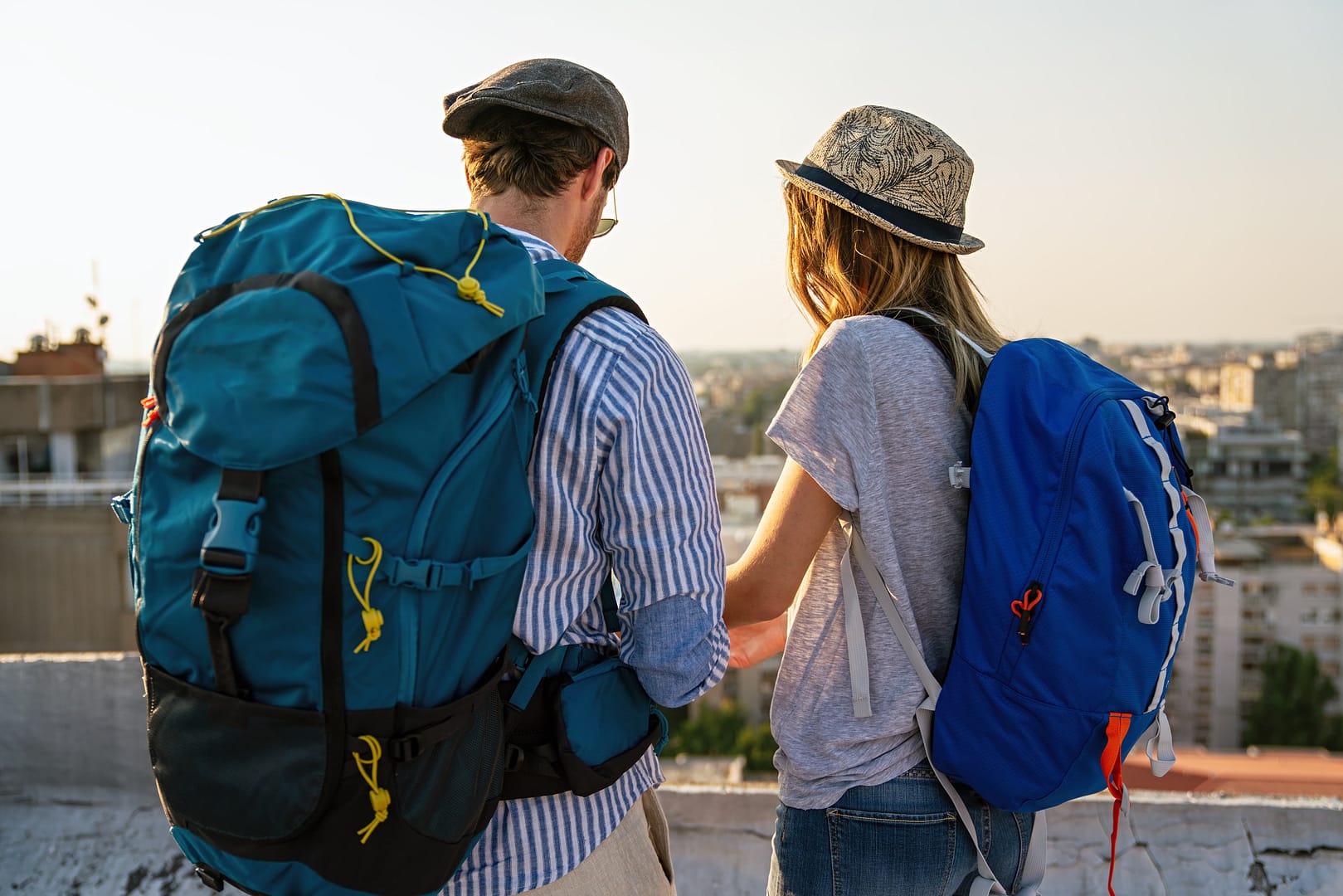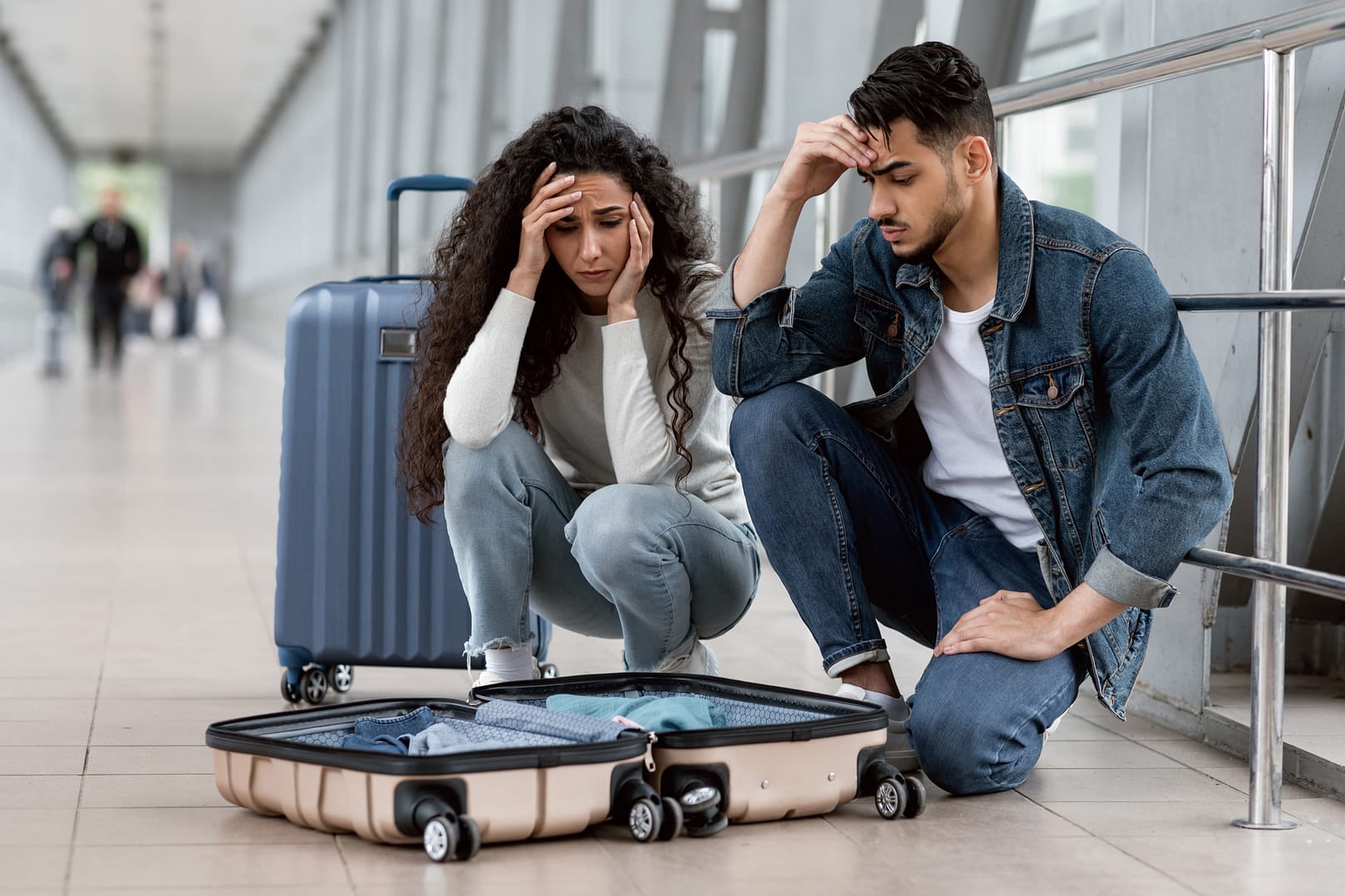It’s happened to all of us. You’re stuffing your carry-on to the brim getting ready for a trip—cramming in that extra pair of shoes, your laptop, travel-sized (and questionably oversized) toiletries. You’ve been looking forward to this vacation all year. Then you get to airport security and suddenly space out everything you’ve ever known about the liquid limit for flights. Uh oh, is sunscreen a gel or liquid? Does our coconut water count as our one personal beverage allowance? Why are they pulling us aside to rifle through our bags??
If you’ve ever found yourself sweating through an interrogation under those TSA heat lamps, you’re not alone, my friend. We’ve all blanked on what qualifies as a “liquid, a gel or an aerosol” when a stone-faced agent is giving us the death glare. Yet somewhere behind that badge is a person who wants you to make your flight too (believe it or not!).
So in this post, we’ll break down the mysterious rules around carry-on items—from whether fingernail polish counts as a gel to if it’s okay to catapult grandma’s fruitcake into orbit in your suitcase (possibly lighter that way??).
Batteries

When traveling with batteries, be sure to follow airline and TSA rules. You'll need to pack them carefully and keep them in a container separate from other items. Batteries are dangerous and must be packaged properly. If not, they may malfunction and pose a threat to the safety of the aircraft.
Batteries are essential for many battery-operated devices. Fortunately, the FAA has established safety guidelines for batteries on airplanes, and TSA security officers are trained to recognize and assess battery-related threats. Common battery types include dry cell alkaline batteries (AA, AAA, C, D, and 9-volt button size cells) and rechargeable dry cell batteries (NiMH and NiCad).
Battery size is also an important consideration. While most airlines allow 99-watt lithium-ion batteries to be carried on board, you may not be able to carry two-hundred-watt batteries. If you are traveling with large amounts of batteries, you'll want to be extra careful.
Razors

If you're flying, you'll probably want to pack razors in your carry-on luggage. There are many TSA-approved razors, including Gillette Fusion ProGlide Razors and Bic razors. You can also bring disposable razors such as Harry's or Dollar Shave Club. These razors use a disposable cartridge that can be replaced with new ones at the airport.
While you can pack electric or disposable razors in your carry-on luggage, razors with a blade attached to the handle are not allowed. You can also pack replacement blades for electric or safety razors but you must store them in your checked baggage. You can also pack cartridges for electric razors in your carry-on, but straight razors must be in your checked baggage.
Lighter

If you're planning to take a lighter on your flight, make sure that you understand the regulations on using it before you get on the plane. The TSA has certain rules regarding the use of lighters and matches on airplanes. They should be stored in bins during the security screening, and then placed in your pocket once you're through the process. You should also keep in mind that you cannot bring a lighter that contains fuel on board a flight. This means that you must bring it in a DOT-approved case if you're planning to use it on the airplane. You should also avoid using electronic or arc lighters on board a flight.
There are a couple of exceptions to this rule, but most airlines don't have a specific policy when it comes to lighters. A TSA employee can check your carry-on luggage and discard any lighters they find. However, if you're planning to bring your lighter in your checked luggage, make sure you've checked with your airline first to avoid getting stuck with a fine.
If you're traveling to the USA, you're allowed to bring a lighter on board. However, you should note that other countries may have different rules. Check out the regulations for your destination country to be sure of what's allowed. You can only bring a disposable or flip lighter on board. Also, a torch lighter or other weapon-shaped lighter is not allowed on board.
If you're using a lighter with flammable liquid, you should make sure that you have a battery backup that can protect you from fire. A lighter with flammable liquid can cause a fire, but it won't burn the entire plane. Strike matches are the best option for travelers who want to use a lighter during their flight.
You can bring one disposable lighter on board a plane if it's a Bic type. But make sure that you pack it in a case that's DOT-approved. This way, you can avoid having the light in your luggage if you're worried about safety concerns.
In addition to avoiding fire risks, you can avoid the hassle of having to pack multiple lighters in your checked baggage. The TSA has strict regulations about the type of lighters that you can bring on board. You can only bring disposable lighters in your carry-on bag if they don't contain fuel. Non-disposable lighters, like Zippo lighters, must be placed in a resealable plastic bag or another container if they're not refillable.
Although disposable lighters are allowed to be brought on board a plane, the TSA doesn't allow plasma, arc, or electronic lighters. Also, you can't bring torch or butane lighters on board.
Makeup

Traveling with your beauty products can be tricky because of the TSA's strict rules. For example, liquid makeup must be packed in quart-size plastic bags or be 3.4 ounces or less. However, solid beauty products like powders, lipsticks, and lip balms can be brought onto an airplane in hand luggage.
In the US, powder makeup must be contained in a container of no more than 12 ounces. Also, any container larger than that will be pulled aside by the TSA for further inspection. Keep in mind that this step could take several extra minutes at the security checkpoint.
Luckily, there are alternatives. Some travelers prefer to bring solid perfume, shampoo, and cleanser bars when traveling.
Deodorant

It's common to be nervous about bringing certain items onto an airplane, and the Transportation Security Administration (TSA) wants to make sure you're aware of all the rules. For example, the TSA doesn't allow liquid deodorant. However, it won't confiscate a stick of deodorant. These products can also be in different containers and different states of matter, so you may need to purchase a travel-sized container.
Several common types of deodorant may not be allowed, though medically prescribed products may be allowed. But, even then, you'll need to carry a prescription or doctor's note to get one through TSA. In addition, you must carry a travel-sized container, which means that it must be less than 3.4 ounces.
Scissors

Scissors are not allowed on planes due to security concerns. They are considered dangerous items and may even be used to threaten or hurt other passengers. In addition, they could be used to hijack a plane. To avoid being denied boarding, check out these tips.
To bring scissors on a plane, you need to put them in a bag and wrap them tightly. Otherwise, TSA officers may confiscate your checked luggage and take action against you. Make sure to choose safety-edged scissors, as these are safer than others. The blades of these scissors must be no longer than 4 inches long. Safety-edged scissors can be used to cut fabric, and are usually small and inconspicuous.
You can bring scissors on a plane if they are smaller than 4 inches. However, you should check the size requirements with the airline you are flying with. Small scissors will be allowed in the carry-on bag, while larger ones will have to be placed in checked luggage.
It is best to pack scissors with small blades that are under 4 inches wide in your carry-on bag. However, if you want to pack them in a checked bag, make sure to wrap them tightly so that they do not cause an issue with airport personnel or other passengers. You can also keep a pair of small scissors under two inches wide in your purse.
The rules for bringing scissors on a plane have changed since the days of the sock monkey. Large scissors are prohibited on planes because they can be classified as dangerous weapons. The same goes for box cutters, knives, corkscrews, and darts.
If you are afraid you might get a ticket for your scissors, make sure they are wrapped in plastic. This will keep the scissors secure and prevent them from getting confiscated. Additionally, the scissors must be under 4 inches long to avoid causing a problem with airport security or other passengers.
Scissors can damage your clothing. To avoid this, you should use scissors in a sheath, which are designed to protect them from damage during transit and at TSA checkpoints. You can also invest in portable electric scissors that can be rolled up and stored in your luggage.
The blades of scissors should not exceed 4 inches in length at the pivot point. It is recommended that you cover the scissors with a make-up case or some other type of plastic case before you pack them. You can also use a leather case for them to prevent damage.
Although scissors are prohibited on airplanes, they are generally not considered dangerous, but it is still possible to bring them on board. These scissors can be packed inside your carry-on luggage or in your checked luggage. However, you must remember to wrap them tightly to prevent them from being confiscated.
Electric Toothbrush

If you're traveling with an electric toothbrush, you may be wondering how to pack it for TSA screening. To be on the safe side, pack the electric toothbrush in a clear quart-size bag, so the TSA can see it without a problem. You can also place the battery-operated electric toothbrush in a hard-sided carry-on case.
Electric Toothbrushes are not prohibited in carry-on baggage, but some models of electric toothbrushes may be confiscated. To ensure the safety of your electric toothbrush, purchase a high-quality toothbrush, and buy a case to protect it from breakage during transit. Also, make sure your toothbrush is fully charged before you fly.
The good news is that bringing your electric toothbrush on a plane is no big deal, but there are a few things you need to remember before packing your toothbrush. You must fully charge it before flying, and you should bring a charger along. Most hotels have charging stations in the rooms, or the front desk can supply you with one.
Aerosols like Hairsprays and Dry Shampoo

Some of the most common items travelers always ask the TSA about include aerosols such as hairspray and dry shampoo. They are allowed in checked baggage, but they must be in a sealed container containing 3.4 ounces or less. Travelers can also purchase special travel bottles for these items.
These aerosol products are not dangerous, but they should be packaged properly. For example, aerosols like dry shampoo and hairspray should be packed in a one-quart plastic bag and accompanied by a bottle of distilled water. However, they should be packed with caution, as not following the rules will result in the aerosol cans being confiscated.
Dry shampoo can come in a variety of sizes and types. Unlike hairspray, it does not take up much space in your bag and will not spill during the checkpoint. Furthermore, it won't count against your liquid allowance. However, dry shampoo in a large bottle will require you to remove it from your hand luggage or hold luggage prior to x-raying.
Bottled Water

While you may be tempted to bring a bottle of water with you on your travels, you might want to reconsider. The Transportation Security Administration (TSA) has a strict policy for liquids, which includes bottled water.
They allow only 3.4 ounces per container in a 1-quart carry-on bag. In addition, the TSA requires passengers to keep liquids in "reasonable quantities."
When going through airport security, remember that you cannot carry bottles of water that contain more than 3.4 oz. However, you can bring reusable water bottles as long as the bottles are empty.
These bottles will be scanned by TSA security. Once you have gone through the security checkpoint, you can fill your bottles back up at nearby refill stations.






